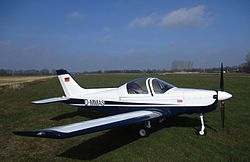Asso V
| Asso V | |
|---|---|

|
|
| Type: | Microlight amateur construction |
| Design country: | |
| Manufacturer: |
Giuseppe Vidor |
| First flight: |
Late 1995 |
The ASSO V (Champion) is a two-seat microlight aircraft designed by the Italian designer Giuseppe Vidor , which is intended and approved for amateur construction.
history
The ASSO V was designed from 1994 to 1995 by Giuseppe Vidor in accordance with the requirements of the Italian Aviation Authority ( Ente Nazionale per l'Aviazione Civile , ENAC) according to Chapter 223, whereby the ENAC approved the simplified construction. It is newly developed, only the Italian "Ferrari of the air", the Aeromere Falco F8L , served as a model for the design .
Then a prototype was built, which first flew in late 1995. Before this, it was subjected to the required load tests on the ground without any problems. The most important evidence was provided, for example the load verification during flight maneuvers ( load multiples ), verification of torsional rigidity for the flutter tests according to the method that the American aviation authority FAA published in Report N 45, straight flight (in connection with the determination of the load multiples during flight maneuvers), the aileron and flap function (maximum load according to evidence as described in Part 223 of the RAI). The prototype was then tested in flight to determine the flight characteristics and the most important properties.
In 2001, the ASSO V was recalculated in Germany according to the BfU. Here, too, all load tests, flutter tests and noise tests were carried out according to the new calculations without any complaints.
The type certificate was issued on August 30, 2004 by the German Aero Club . The pattern supervisor is Fritz Mürkens from Garching / Alz in Upper Bavaria.
The Pioneer 300 was later derived from the ASSO V. It differs from the Asso V by its outer skin made of carbon fiber reinforced plastic . The aircraft is still manufactured today as a kit aircraft in various countries based on the construction plans.
construction
The ASSO V is primarily made of wood, using red fir , spruce , pine or hemlock . The outer skin is made of birch plywood , okume or poplar .
Aircraft structure
The fuselage of the ASSO V is made in the classic wooden construction and only some connecting parts are made of steel or aluminum . The wing structure is also made of wood. The leading edges of the wings are planked with birch plywood , as is the entry area to the cockpit. The entire wings are covered with Dacron, a polyester fabric . The wings have wide ailerons and flaps , which are also made of wood and covered with Dacron.
The rudder is made of wood. The fixed part of the rudder is completely covered with birch plywood, the moving part is only covered with polyester fabric. Wings and elevators are easy to dismantle to enable the aircraft to be transported on the ground. The connection of the wings and elevator to the fuselage is made with steel screws, in addition, aluminum plates are screwed and glued to the ends of the main spars for reinforcement.
The fuselage consists of a basic structure made of wooden ribs, reinforced with birch plywood or okume panels. The first bulkhead (in the direction of flight) carries the fire bulkhead and the engine mount. The latter is made from steel tubes. The engine is resiliently suspended from the engine mount. The retractable nose wheel landing gear is made of high quality steel. The main landing gear has a track width of 160 cm, has a hydraulic brake system and is equipped with rubber buffers or shock absorbers. The nose wheel is connected to the rudder pedals by steel cables and is therefore steerable. Like the main landing gear, it is equipped with rubber buffers or shock absorbers.
cockpit
The seating arrangement in the heated cockpit is side by side, with both seats having a controller. The cockpit glazing is in two parts, with a fixed windscreen and a sliding hood that cannot be opened during flight and that is adapted to the contour of the aircraft.
control
The ASSO V is three-axis controlled , whereby the elevator and ailerons are controlled with a stick and the rudder with pedals. The landing flaps and the brakes are each operated with a lever that is attached between the seats and can be operated by the pilot or copilot. The throttle lever or cable is located on the left and right side of the cockpit on the instrument panel. The ailerons and the flaps are operated by stable push rods. The elevator is a trim installed, the operating lever is located between the seats. The elevator is controlled with a combination of control cables and rods. The rudder has no trim and is linked via control cables.
Technical specifications
- Seats: 2
- Length: 6.10 m
- Wingspan: 8.18 m
- Wing area: 10.94 m²
- Cabin width: 1.05 m
- Cabin height: 1.03 m
- Empty weight: 280 kg
- Max. Takeoff weight: 450 kg
- Fuel: 60 l (two 30 l wing tanks)
- Top speed: 249 km / h
- Speed at max. Performance 219 km / h
- Cruising speed: 190–200 km / h
- Minimum speed: 63 km / h
- Max. Flight altitude: 5000 m
- Take-off distance: 110 m
- Landing distance: 140 m
- Max. Cross wind: 30 km / h
- Petrol consumption: 12–16 l
- Gradeability: 7.5 m / s
- Engines: Rotax 912 S / ULS with 100 HP or Rotax 912 / UL with 80 HP, Limbach 2000 EB, JPX 2325
See also
- List of aircraft types
- ASSO IV whiskey
- ASSO VI Junior
- ASSO XI Sprint